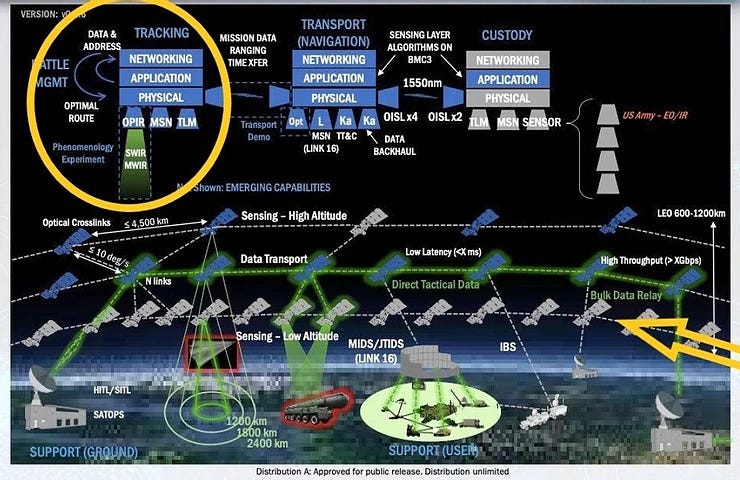Looking at the Space Development Agency’s Tracking Layer Selections

The following covers a topic that was long near and dear to my heart: low Earth-orbiting satellites with infrared sensors scanning the Earth. I’ve worked with infrared satellites for a good long while. In this case, SpaceX is leveraging its satellite manufacturing capability and building four satellites for the U.S. Department of Defense (DoD). SpaceX will be manufacturing these four satellites, based on its Starlink bus, with an infrared sensor payload and optical inter-satellite links (OISL).
Tracking Layer Selection Observations
These satellites are for the Space Development Agency’s (SDA) Tracking Layer (designated “Tranche 0”). According to SDA’s request for proposals, the Tracking Layer includes:
“~8-10 interconnected satellites with cross links with wide field of view (WFOV) infrared sensors for missile warning and tracking. The specific requirements and technical challenges for this solicitation include, but are not limited to, low-recurring-cost satellite buses, mass-producible OPIR mission payloads and associated data processing, and interoperable crosslinks and networking.”
In English, what SDA wants are satellites with infrared sensors that detect missile launches and track them through their flight (cruise missiles, too). The satellites will be able to pass data from the sensor to other satellites, which then pass the data to an operations center. The satellites would ideally be inexpensive, and the infrared sensor (OPIR--overhead persistent infrared) payload should be easy to manufacture in large batches.
SpaceX was one of two companies awarded an SDA contract for manufacturing Tracking Layer satellites. The other company, L3Harris, is also on the hook for four satellites. SpaceX’s contract value was for ~$149, while L3Harris received ~$194 million, and both must deliver their satellites by September 2022.
This award scenario has a similar…**flavor**...to a few of NASA’s commercial development programs. The fact that the SDA chose a legacy defense-oriented company (which was two legacy defense companies not too long ago), L3Harris, and then SpaceX may have been inadvertent. It kind of mirrors NASA’s selection of Orbital Sciences and SpaceX, or Boeing and SpaceX (yes, there were others selected, too). But to give credit where it’s due, at least the SDA is looking at companies like SpaceX, to begin with.
Based on the very modest performance of the defense companies SpaceX has faced in its other endeavors, it’s very likely SpaceX will outpace L3Harris’ efforts--for less money and with more capability. If L3Harris manages to produce four overhead persistent infrared (OPIR) satellites on schedule, then the SDA potentially still comes out ahead.
Especially when compared with earlier ambitious plans and programs using infrared sensors. For the DoD, the Tracking Layer schedule is quick, even for demonstration purposes, in fielding a relatively inexpensive space-based infrared system. The pacing of earlier similar programs using similar technologies wasn’t even close.
Star Wars History=High Costs and Little Return
The SDA system development is a large extension of the Strategic Defense Initiative’s (SDI=Star Wars) plans. In the mid- to late-80s, the United States military (backed by President Ronald Reagan) was attempting to push against the doctrine of Mutually Assured Destruction between the U.S. and U.S.S.R. by pursuing a layered space-based defense system. Back then, the idea of low Earth-orbiting Demonstration/Validation Space-Based Surveillance and Tracking System (SSTS) satellites was introduced and took hold. The satellites would (deep breath):
“...provide tracking in the post-boost and midcourse phase of the missile trajectory. The SSTS would also discriminate among reentry vehicles, lightweight penetration aids, and space debris. The SSTS platform would consist of a telescope, a focal plane array, a cryocooler, and associated processor and communications hardware and software, as well as necessary attitude control systems. The optical system would be designed to gather electromagnetic radiation which would be focused on a plane containing infrared-sensitive detectors…” Space-Based Surveillance and Tracking System (SSTS), Environmental Assessment, p. 1-4, 1987.
SSTS was one of three space layers identified in SDI and would provide missile tracking data to space- and ground-based interceptors. The DoD never deployed those satellites. The 35-year old idea of these types of space systems iterated through names, missions, and agencies. It cost taxpayers several billion dollars as the decades went by. Now the SDA is moving in.
Before the SDA’s Tracking Layer awards, the last operational iteration of this space-based warning and tracking system was the Space-Based Tracking and Surveillance System (STSS--not kidding). STSS consists of two Missile Defense Agency-operated demonstration satellites in LEO, manufactured for $869 million (and then some). They’ve been participating in the Missile Defense Agency’s neverending test death spirals since their deployment in 2009. Hopefully, SDA has more in mind than constant testing of the eight satellites the two companies are manufacturing.

STSS-D/Tracking Layer Comparisons
The total $343 million the SDA is paying L3Harris and SpaceX for eight satellites is much less than what the MDA paid for two and significantly less than all the dollars poured into “development” systems since 1984. There are differences between the STSS-D satellites and the SDA’s requirements for its Tracking Layer satellites.
STSS-D satellites are in a much higher orbit, 1350 km, whereas SDA’s Tracking Layer will be around 600 km (gold arrow pointing to notional Tracking Layer orbit in image). The STSS-D satellites have two sensors--a wide-view infrared sensor for finding objects, and a narrow-view sensor to track objects found by the wide-view sensor. The SDA’s satellites will have a single wide-view infrared sensor, which I assume will continuously stare down at the Earth seeking launches and other interesting energy profiles. It’s not clear whether that single sensor will also be able to go into a “narrow-view” mode for tracking objects found during wide-view mode. Since the SDA requires these satellites to conduct tracking, those sensors need to focus on an object (ideally, several objects).
The MDA’s STSS-D satellites also can talk with each other using radio. However, they are dependent on receiving and passing data through ground terminals before being relayed to other satellite systems. It appears that the SDA’s Tracking Layer satellites are wholly reliant on laser, or optical, inter-satellite links (OISL). Right now, it seems as if the Tracking Layer satellites won’t link to each other--instead, they will communicate through the SDA’s higher-orbiting Data Transport Layer (communications network) satellites with OISLs. Such a relay system can mean a Tracking Layer satellite over Russia or China will still get data to a ground station in the U.S. and receive commands from it--near instantaneously.
But this is where things get a little iffy and complicated with the SDA’s plans. The Transport Layer satellites must be ready for the Tracking Layer satellites. Without the Transport Layer satellites, the Tracking Layer doesn’t appear to be able to communicate--with anything. York Space Systems and Lockheed Martin are manufacturing Transport Layer ten satellites each. Those are also supposed to be completed around the last quarter of the fiscal year 2022. Will those satellites be ready for L3Harris’ and SpaceX’s satellites?
This is an ambitious project, and the SDA appears to be very serious about its undertaking. If this works, the SDA will very much be in a stronger starting position than SDI and its iterations--for much less money.




Comments ()